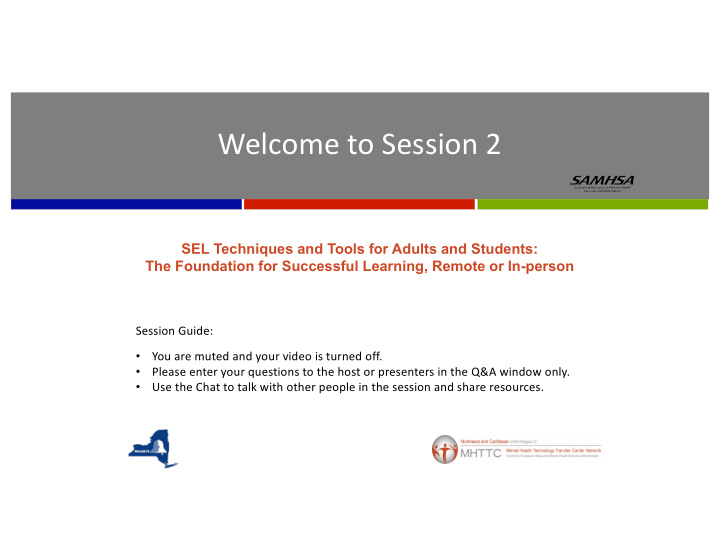



Welcome to Session 2 SEL Techniques and Tools for Adults and Students: The Foundation for Successful Learning, Remote or In-person Session Guide: You are muted and your video is turned off. • Please enter your questions to the host or presenters in the Q&A window only. • Use the Chat to talk with other people in the session and share resources. •
Zoom Guide
SEL Techniques and Tools for Adults and Students: The Foundation for Successful Learning Whether Remote or In-person Supporting School Mental Health in the Wake of COVID-19 August 18, 2020 Supporting, Connecting and Empowering Schools
Welcoming Grounding Activities Weather reports
SEL programs benefit children for months and even years (casel.org). 82 97,000+ 6 mo – 18 yrs Students in kindergarten Different programs Effects assessed through middle school reviewed after programs completed (38 outside U.S.) SEL Students Benefit in Many Areas Higher social and emotional competencies Academic performance Conduct problems among SEL students at the end of the initial intervention was the best predictor of long- SEL skills Emotional distress term benefits. Positive attitudes Drug use Benefits were the same regardless of Positive social behaviors socioeconomic background, students’ race, or school location.
SEL Benefits Adults Teachers who possess social and emotional competencies are more likely to stay in the classroom longer . Teachers with high levels of social competence are better able to protect themselves from burnout by: ü developing and managing nurturing relationships with their students ü managing behavior in their classrooms ü serving as behavioral role models for children ü regulating their own emotions Jennings, P.A. & Greenberg, M.T. (2009) The Prosocial Classroom: Teacher Social and Emotional Competence in Relation to Student and Classroom Outcomes. American Educational Research Association.
CASEL 5: SEL Competencies • Identifying emotions • • Self-perception/Identity • Impulse control • Recognizing strengths • Stress management • Sense of self-confidence Self-discipline • Self-motivation • Perseverance • • Perspective-taking Goal-setting • • Organizational skills Empathy • Appreciating diversity • Respect for others • Identifying problems • • • Analyzing situations Communication • Solving problems • Social engagement • Evaluating • Building relationships • Reflecting • Working cooperatively • Ethical responsibility Resolving conflicts • Helping/Seeking help www.casel.org 7
SEL Critical in this Moment • Trauma-informed strategies • Talking about race and racism • Self-care and coping skills • Building relationships from a distance • Student engagement • Family engagement • Potentially 3 different learning environments at the same time (online, hybrid, in the classroom)
SEL in this Moment (casel.org) • Self-awareness - “critical when things are uncertain and socially turbulent; in understanding our cultural, racial, and social identities; examining our implicit biases” • Self-Management - “coping with grief and loss; developing resilience; expressing social agency against injustices” • Social awareness - “understanding of inequities and impact of systemic racism” • Relationship skills - “build meaningful connections across race, culture, age; support one another through grief and struggle” • Responsible decision-making - “make decisions that promote public health and collective well-being; engage in collective action to create a more just and equitable society”
Top 5 Recommendations for SEL in the Classroom 1. Provide daily SEL instruction and practice to foster a sense of belonging and safety as students return to close proximity with others. 2. Emphasize school culture and rethink school-wide celebrations and traditions. 3. Make your safety measures visible for students and clearly communicated to families. 4. Maintain regular communication with families 5. Take care of your own adult SEL needs 10
Provide daily SEL instruction and practice to foster a sense of belonging and safety In the chat box, please share: What are some ways you already do this? 11
Provide daily SEL instruction and practice to foster a sense of belonging and safety Other ideas: ● Daily community building activities, like morning meetings, class meetings, games, and activities. ● Connect with students as a whole class, in small groups, or one on one to check in with each other (remote setting). ● Provide frequent opportunities for reflection and feedback to identify needs as students adapt to a new environment. ● Use calming strategies to support students. ● Consider providing SEL instruction through a video-based curriculum. 12
Emphasize school culture and rethink school-wide celebrations and traditions. 13
Make safety measures visible for students and clearly communicated to families ● Use positive language to explain the purpose for each safety measure “This is how we care for one another” “We are taking care of ourselves and each other” ● Practice, practice, practice (Use interactive modeling as a teaching strategy) 14
Maintain regular communication with families ● Select a means for communicating with families on a daily/weekly basis. ● Provide support for families to continue to facilitate SEL at home. ● Create weekly challenges or activities to share with families and foster a sense of community school-wide while students are learning from home. 15
Take care of your own social-emotional needs ● Trim Your List ● Allow Yourself to Stop ● Embrace Vulnerability ● Reach Out to Experts ● Pass Your Umbrella
Social – emotional Skills Thriving Student Positive Schools and Staff Culture and and Health Climate Students Organized and Coordinated School Data Driven Decision Professional Development School Culture Professional Learning Communities and Climate Initiative, 2019
To create school environments that set-up all students for success in school and life. 18
Resources www.SEL4NJ.ORG www.CASEL.ORG www.Edutopia.org www.ascd.org/ascd-express/vol15/num13/5-strategies-for-teacher- self-care.aspx www.movethisworld.com/white-papers/toolkit-sel-planning- for-reentry/
Recommend
More recommend